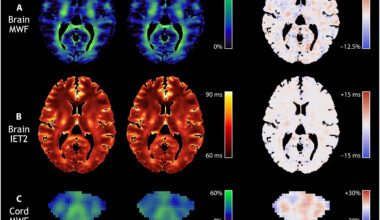Check out some of the papers that were published by DMCBH members in the past few weeks:
Helen Tremlett: “Risk of Multiple Sclerosis Among Users of Antitumor Necrosis Factor Alpha in Four Canadian Provinces: A Population-Based Study”
The findings of this study contribute substantially to the understanding of the increased risk of MS with anti-TNFα use and could help doctors and patients with rheumatic diseases who require treatment with an anti-TNFα drug make better informed decisions. In particular, they can weigh the risk versus quality-of-life benefits between the use of an anti-TNFα drug or an alternative, comparable medication not associated with MS.
Read a lay summary by Sharon Roman, a patient-partner working with Dr. Tremlett
Helen Tremlett: “Sex and Age Differences in the Multiple Sclerosis Prodrome”
Significant differences in how the early stage of MS presents was observed for males, females and between age groups, providing further insight into the MS prodrome. Altogether, the findings suggest that sex and age may be used to improve the accuracy of risk prediction models. The use of healthcare data to distinguish between people with MS and those without holds promise.
Read a lay summary by Sharon Roman, a patient-partner working with Dr. Tremlett
Alexander Rauscher: “Orientation dependence of R2 relaxation in the newborn brain”
In this study, we have investigated the dependence of R2 relaxation rates on local fiber orientation in nearly unmyelinated human white matter. The observed orientation dependence is distinctly different from that found in the myelinated brain. In the near-absence of myelin, residual dipolar coupling is suggested as the mechanism causing orientation dependence. A model of residual dipolar coupling yielded good agreement with the data while susceptibility-based models were inconsistent with our observations in newborns. The characteristic orientation dependence in R2 at different developmental stages may serve as a potential marker for brain development.
As the principal receptor that mediates both synaptic and tonic inhibition of neurons in the brain, the A-type gamma-aminobutyric acid receptor (GABAAR) is functionally important for maintaining the balance between neuronal excitation and inhibition. Here, we report the identification of netrin-1 as an endogenous allosteric modulator of GABAARs. Following increased neuronal excitability, netrin-1 is secreted and binds to the extracellular domains of GABAAR subunits, thereby inducing homeostatic upscaling of GABAAR-mediated synaptic efficacy and currents. Surprisingly, this homeostatic plasticity is primarily mediated by increasing GABAAR single-channel conductance. Our study reveals an important role of netrin-1 as an endogenous GABAAR allosteric modulator in maintaining neuronal excitation-inhibition balance, a fundamental process for brain function and dysfunction.
Repetitive transcranial magnetic stimulation (rTMS) can elicit 45–55 % response rates and may alleviate suicidality symptoms in treatment resistant depression (TRD). Blunted anticipatory reward sensitivity and negatively biased self-referential processing may predict trajectories of depressive and suicidality symptoms in rTMS for TRD and be modulated during treatment.
Kiran Soma: “Isoflurane stress induces region-specific glucocorticoid levels in neonatal mouse brain”
The profound programming effects of early life stress (ELS) on brain and behavior are thought to be primarily mediated by adrenal glucocorticoids (GCs). However, in mice, stressors are often administered between postnatal days 2 and 12 (PND2–12), during the stress hyporesponsive period (SHRP), when adrenal GC production is greatly reduced at baseline and in response to stressors. During the SHRP, specific brain regions produce GCs at baseline, but it is unknown if brain GC production increases in response to stressors. In this study, data illustrates the rapid and profound changes in stress physiology during neonatal development and suggests that neurosteroid production is a possible mechanism by which ELS has enduring effects on brain and behavior.
Is mania in bipolar disorder (BD) associated with dopamine transporter (DAT) density? In this cross-sectional study of 26 individuals with BD (9 with current mania; 17 with recently remitted mania) and 21 healthy control individuals, patients with BD were observed to have lower DAT density in the striatum with more pronounced reduction in individuals with current mania and a negative correlation between DAT density and manic symptom severity. These findings indicate that mania was associated with reduced DAT density and remitted mania was associated with DAT levels that approximated those present in individuals without BD; these results have potential implications for drug development for mania.
Kota Mizumoto: “Channel-independent function of UNC-9/Innexin in spatial arrangement of GABAergic synapses in C. elegans”
Precise synaptic connection of neurons with their targets is essential for the proper functioning of the nervous system. A plethora of signaling pathways act in concert to mediate the precise spatial arrangement of synaptic connections. Here we show a novel role for a gap junction protein in controlling tiled synaptic arrangement in the GABAergic motor neurons in Caenorhabditis elegans, in which their axons and synapses overlap minimally with their neighboring neurons within the same class.
Alterations in different aspects of dopamine processing may exhibit different progressive behaviours throughout the course of Parkinson’s disease. This study used a novel data-driven multivariate approach to quantify and compare spatiotemporal patterns related to different aspects of dopamine processing from cross-sectional Parkinson’s subjects.
Jehannine Austin: “Pharmacogenomic Testing for Major Depression: A Qualitative Study of the Perceptions of People with Lived Experience and Professional Stakeholders”
With increasing evidence for the clinical utility of pharmacogenomic (PGx) testing for depression, there is a growing need to consider issues related to the clinical implementation of this testing. The perspectives of key stakeholders (both people with lived experience [PWLE] and providers) are critical, but not frequently explored. The purpose of this study was to understand how PWLE and healthcare providers/policy experts (P/HCPs) perceive PGx testing for depression, to inform the consideration of clinical implementation within the healthcare system in British Columbia (BC), Canada.
DMCBH research featured in articles:
- Sharon Roman: “A journey with no roadmap—The need for validated criteria of the MS prodrome”
- Mark Cembrowski: “Patch-seq takes neuroscience to a multimodal place”


